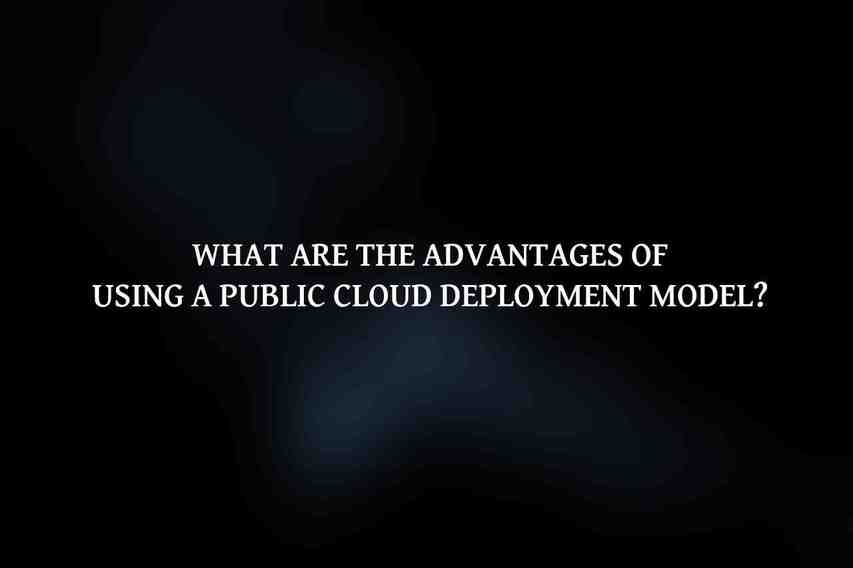When considering cloud deployment models, it’s essential to understand the various options available to tailor your business needs effectively. The primary types of cloud deployment models include:
| Deployment Model | Description |
|---|---|
| Public Cloud | Third-party-owned and operated, accessible over the internet, offering scalability and cost-effectiveness. |
| Private Cloud | Single-tenant, dedicated infrastructure that can be hosted on-premises or offsite, providing enhanced security. |
| Hybrid Cloud | Combination of public and private clouds, allowing flexibility in workload management and resource optimization. |
| Community Cloud | Shared infrastructure among specific organizations, promoting collaboration while maintaining data segregation. |
B. Characteristics and Key Differences
Each deployment model has distinct characteristics that differentiate them in terms of ownership, control, cost structure, scalability, and security. Understanding these differences is crucial in making the right choice for your business: Read more on Top Strategies for Public Cloud Deployment: Expert Tips & Tricks
- Ownership and Control: While public clouds offer shared resources, private clouds provide exclusive control over infrastructure.
- Cost Structure: Public clouds typically follow a pay-as-you-go model, while private clouds may have fixed costs and potentially higher upfront expenses.
- Scalability and Flexibility: Public clouds excel in scalability, while private clouds offer customization and control over resource allocation.
- Security and Compliance: Private clouds often boast enhanced security measures and comply with specific industry regulations, making them suitable for sensitive data handling.
Evaluating Business Needs
A. Business Objectives and Requirements
Before selecting a cloud deployment model, businesses need to assess their specific requirements, including application workloads, data storage needs, regulatory compliance, and security standards. Learn more about Ultimate Guide to Cloud Deployment Models: Understanding Your Options
- Application Workloads: Different cloud models may be better suited for varying application requirements, such as performance demands or data sensitivity.
- Data Storage and Management Needs: Consider the volume and nature of data that needs to be stored, accessed, and managed within the cloud environment.
- Regulatory Compliance and Security Standards: Ensure that the chosen deployment model aligns with industry regulations and offers the necessary security measures.
B. Cost Considerations
Cost considerations play a significant role in selecting a cloud deployment model, including factors like pricing structures, total cost of ownership (TCO), and scalability options.
- Pay-as-you-go Pricing vs. Fixed Costs: Evaluate whether a variable pricing model or fixed costs better align with your budget and usage patterns.
- Total Cost of Ownership (TCO) Calculation: Calculate the overall costs associated with the chosen deployment model over its lifecycle for accurate budgeting.
- Scaling Costs and Resource Consumption: Understand how costs scale as resource consumption changes, ensuring cost-efficient scalability.
C. Security and Compliance

Security and compliance are critical aspects that should not be overlooked when evaluating cloud deployment models, considering factors like data protection regulations, provider security measures, and compliance requirements.
- Data Protection and Privacy Regulations: Ensure that the chosen model complies with data protection laws and industry-specific privacy regulations.
- Cloud Provider’s Security Measures and Certifications: Verify the security protocols and certifications of cloud providers to safeguard your data effectively.
- Risk Assessment and Compliance Requirements: Perform a thorough risk assessment aligned with compliance requirements to mitigate potential security vulnerabilities.
Stay tuned for the continuation of this article…
Frequently Asked Questions
What factors should be considered when choosing a cloud deployment model?
Some factors to consider include the level of control, scalability, security requirements, cost, and compliance needs of your business.
What is the difference between public, private, and hybrid cloud deployment models?
Public cloud is a shared environment managed by a third-party provider, private cloud is dedicated to a single organization, and hybrid cloud combines elements of both.
How can I determine which cloud deployment model is best for my business?
Assess your business needs, goals, budget, and technical requirements to decide whether public, private, or hybrid cloud would be most suitable.
What are the advantages of using a public cloud deployment model?

Public clouds offer cost-effectiveness, scalability, flexibility, and are ideal for businesses with unpredictable workloads or limited IT resources.
What are the security implications of different cloud deployment models?
Public clouds may have security concerns due to shared resources, while private clouds offer greater control and security. Hybrid clouds provide a balance of both.

